
SomeaKenya provides Updated and Revised notes for the current CPA syllabus. Revision kits (Past papers with answers) are also available to help you with revision of the upcoming exams. You can get these materials in Hardcopies (Printed and Binded) and also available in Softcopy form when you subscribe on mobile or Desktop/Laptop someakenya Application. (Note: Softcopies are not Printable and can only be read using android phones) Click here to download SOMEAKENYA APP from Google Playstore.
Full Access to these notes/Kit on Desktop/Laptop via https://desktop.someakenya.co.ke
Or through Our Mobile App


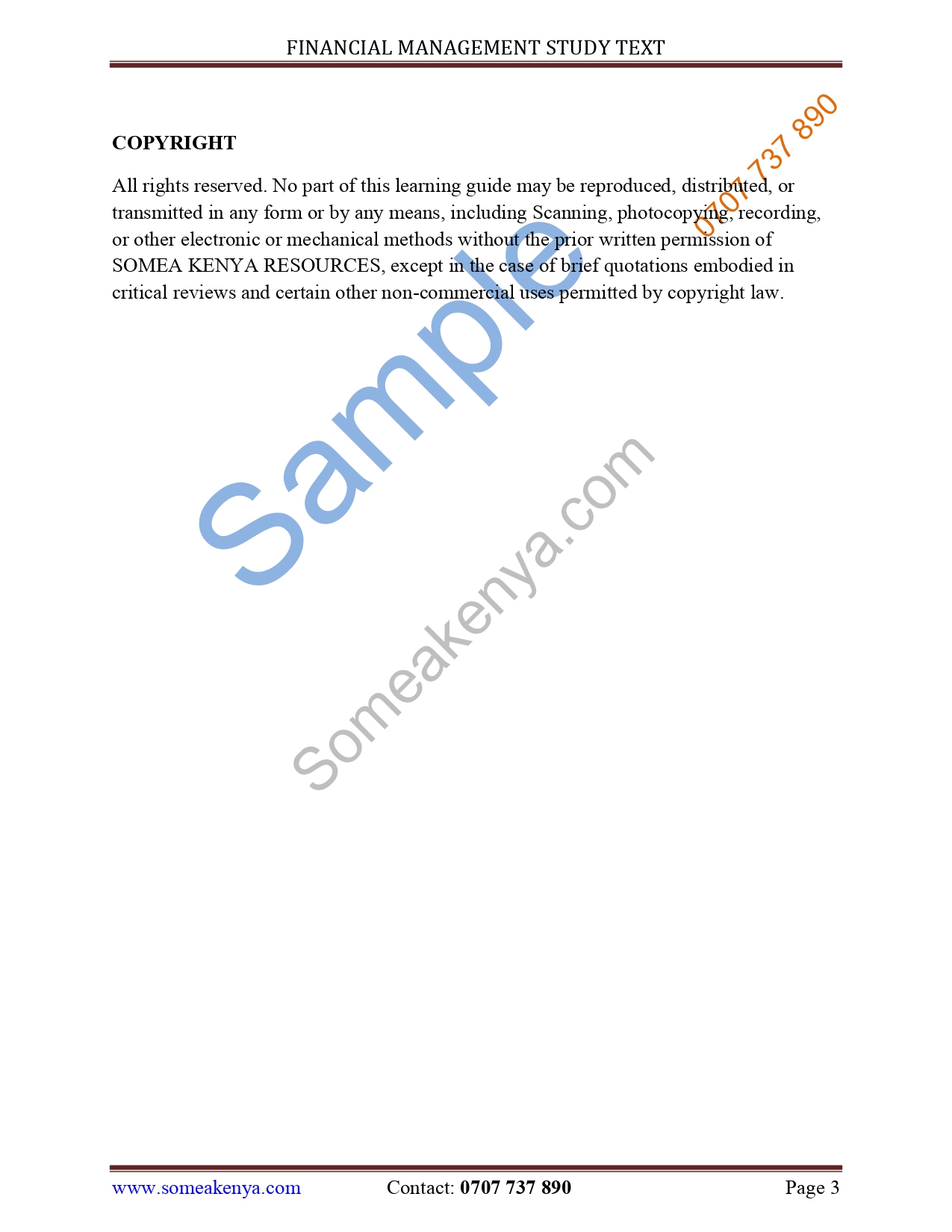
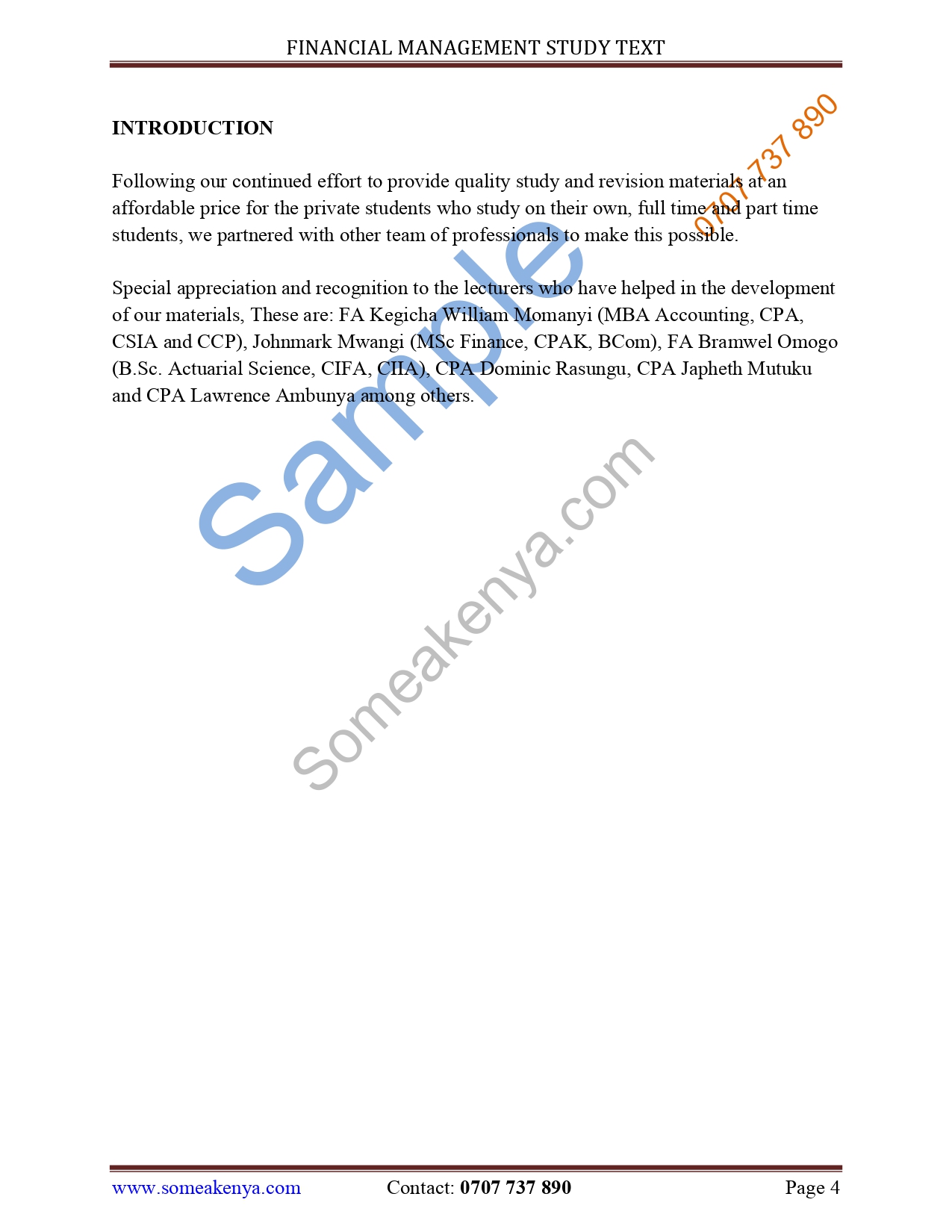


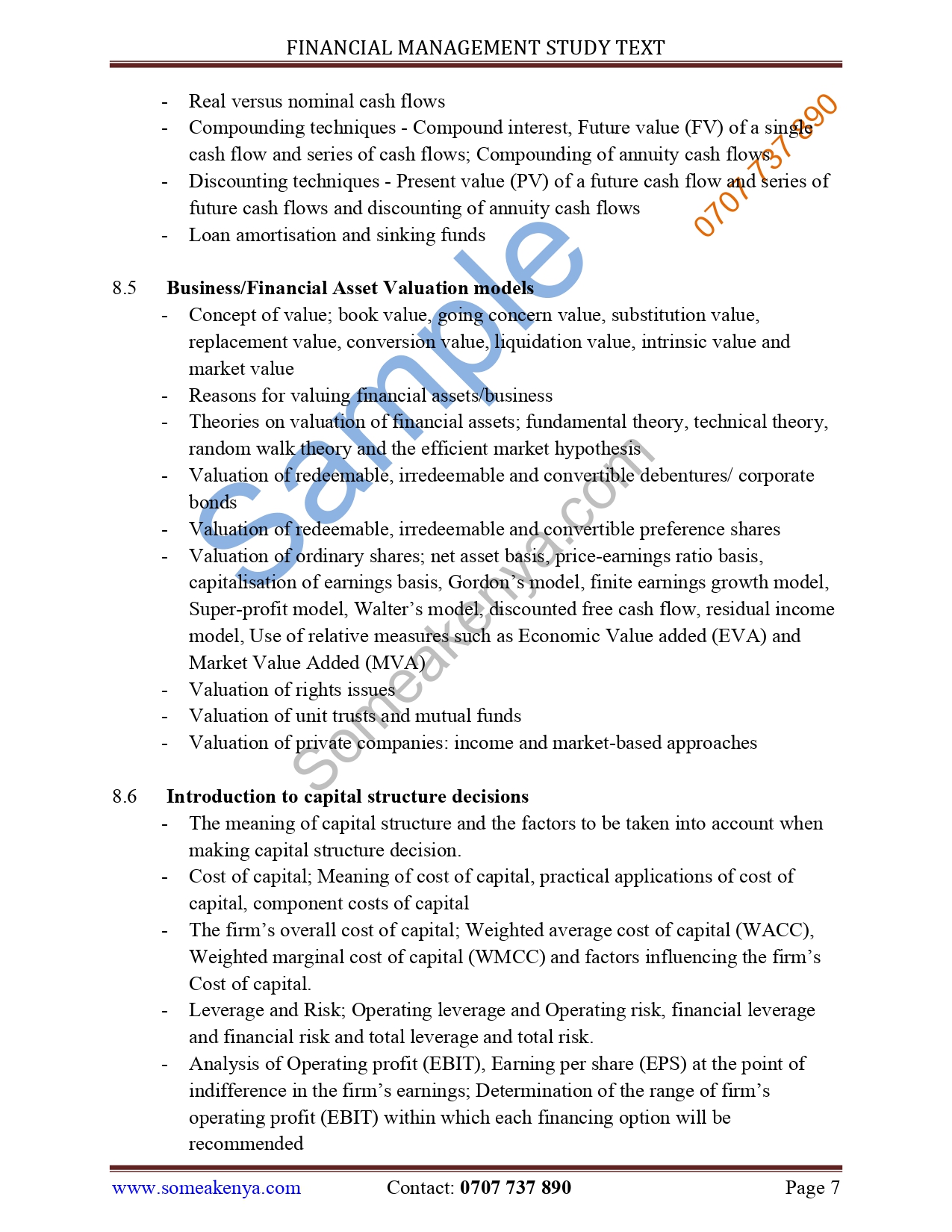

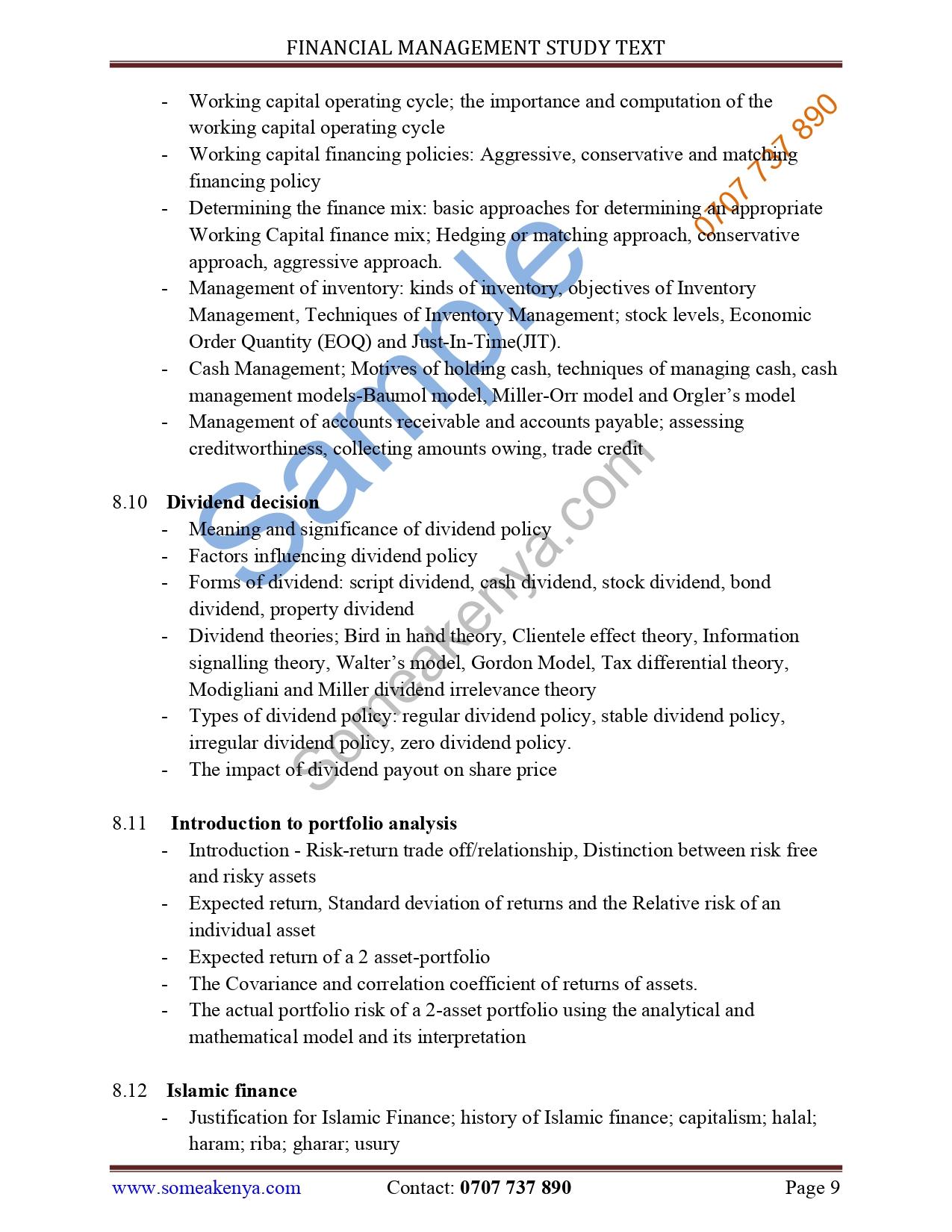

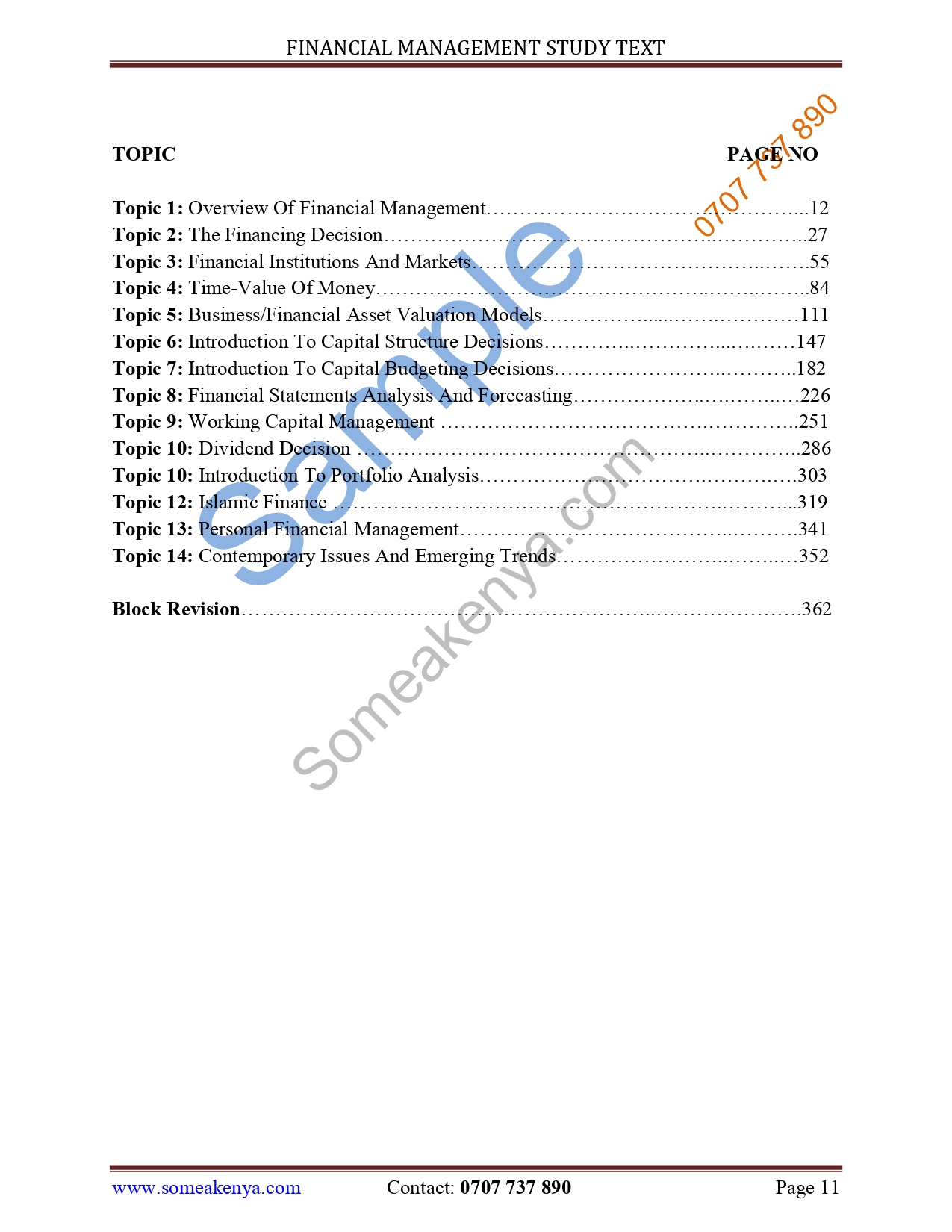
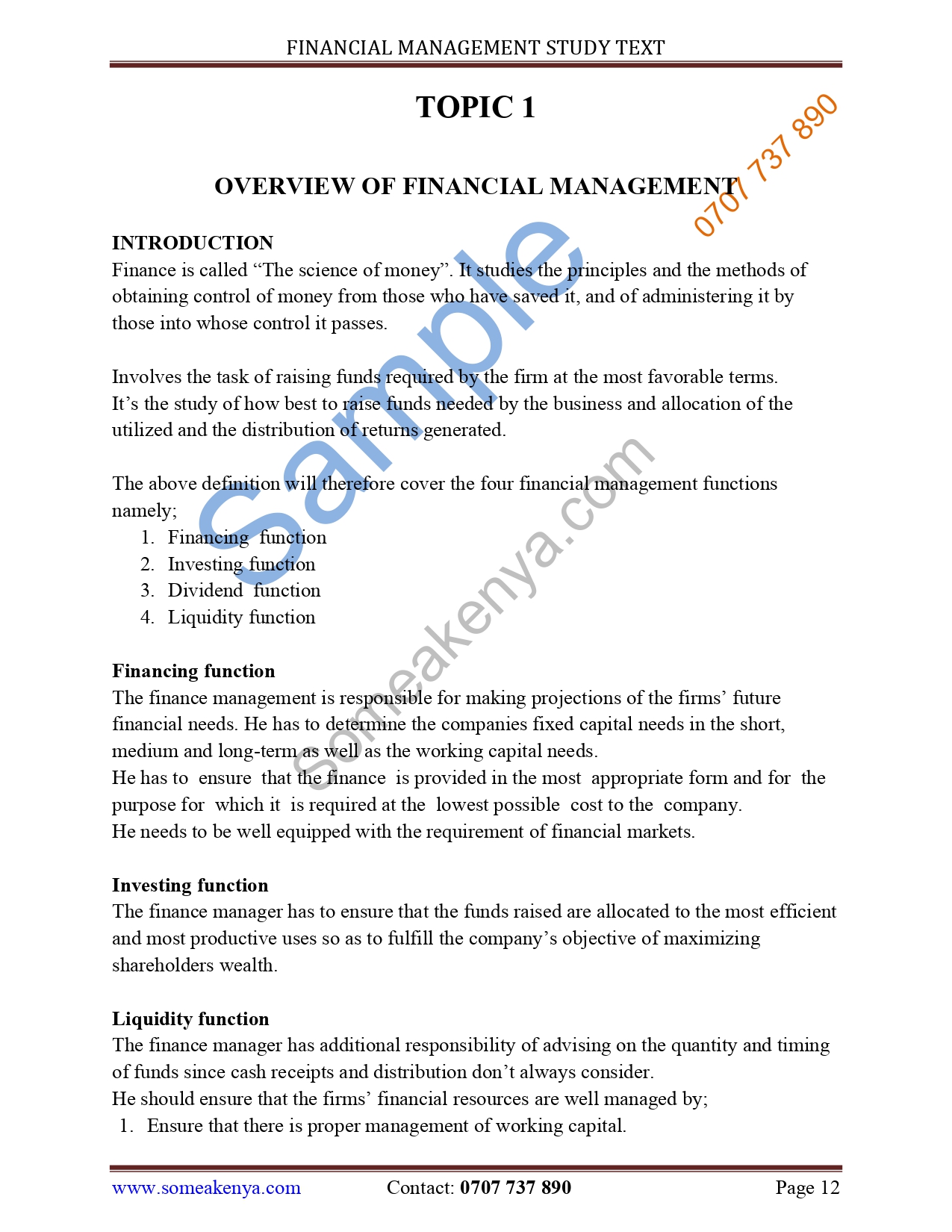



Full Access to these notes/Kit on Desktop/Laptop via https://desktop.someakenya.co.ke
Or through Our Mobile App
Topics covered
CONTENT
8.1 Overview of financial management
- Theoretical framework of financial management – The role and responsibilities of a finance manager towards shareholders, employees, society, government and other stakeholders.
- Goals of a firm and corporate strategy; financial and non-financial objectives, overlaps and conflicts among the objectives
- Agency theory, stakeholder’s theory and corporate governance
- Measuring managerial performance, compensation and incentives
- Ethical issues in financial management
8.2 The financing decision
- Nature and objectives of the financing decision
- Factors to consider when making financing decisions
- Sources of finances for enterprises; internally generated funds and the externally generated funds, long term sources (equity, debt, hybrids, lease finance, venture capital, business angel finance, private equity, asset securitisation and sale, Islamic finance and initial coin offerings), medium term sources such as medium term loans and hire purchase financing and short term sources of finance such as overdraft finance, trade credit, issue of commercial papers, accruals, deferred income; characteristics of each source of finance, pros and cons of the various sources of finance.
- Evaluation of financing options
- Methods of issuing ordinary shares – Public issue, private placement, bonus issue, employee stock option plans (ESOPS) and rights issues
8.3 Financial institutions and markets
- Overview of a financial system – Financial markets, financial institutions and financial instruments
- Nature and role of financial markets – primary and secondary securities market, money and the capital markets, over-the counter and organised market, derivatives market, mortgage market, forex market
- Nairobi securities exchange (NSE, or equivalent entity in other jurisdictions) – The role and functions of the securities exchange, securities exchange terminologies, security exchange listing and cross border listing, share indices, timing of investment at the securities exchange, Central depository system and automated trading system, de-mutualisation
- Stock market indices
- Central depository system and automated trading system
- Timing of investment at the securities exchange – Dow theory and Hatch system of timing
- The financial institutions and intermediaries: commercial banks, savings and loans associations and co-operative societies, foreign exchange bureaus, unit trusts and mutual funds, insurance companies and pension firms, insurance agencies and brokerage firms, investment companies, investment banks and stock brokerage firms, micro-finance institutions and small and medium enterprises (SMEs)
- Regulation of financial markets; Central bank of Kenya (CBK, or equivalent entity in other jurisdictions) – The role of the Central bank and the Monetary policy of the central bank; Capital market authority and the Insurance regulatory authority
- Factors responsible for the rapid development of financial institutions and markets
- Risks facing financial institutions
8.4 Time-value of money
- Concept of time value of money
- Relevance of the concept of time value of money in financial management
- Time value of money versus time preference of money
- Time line
- Real versus nominal cash flows
- Compounding techniques – Compound interest, Future value (FV) of a single cash flow and series of cash flows; Compounding of annuity cash flows
- Discounting techniques – Present value (PV) of a future cash flow and series of future cash flows and discounting of annuity cash flows
- Loan amortisation and sinking funds
8.5 Business/Financial Asset Valuation models
- Concept of value; book value, going concern value, substitution value, replacement value, conversion value, liquidation value, intrinsic value and market value
- Reasons for valuing financial assets/business
- Theories on valuation of financial assets; fundamental theory, technical theory, random walk theory and the efficient market hypothesis
- Valuation of redeemable, irredeemable and convertible debentures/ corporate bonds
- Valuation of redeemable, irredeemable and convertible preference shares
- Valuation of ordinary shares; net asset basis, price-earnings ratio basis, capitalisation of earnings basis, Gordon’s model, finite earnings growth model, Super-profit model, Walter’s model, discounted free cash flow, residual income model, Use of relative measures such as Economic Value added (EVA) and Market Value Added (MVA)
- Valuation of rights issues
- Valuation of unit trusts and mutual funds
- Valuation of private companies: income and market-based approaches
8.6 Introduction to capital structure decisions
- The meaning of capital structure and the factors to be taken into account when making capital structure decision.
- Cost of capital; Meaning of cost of capital, practical applications of cost of capital, component costs of capital
- The firm’s overall cost of capital; Weighted average cost of capital (WACC), Weighted marginal cost of capital (WMCC) and factors influencing the firm’s Cost of capital.
- Leverage and Risk; Operating leverage and Operating risk, financial leverage and financial risk and total leverage and total risk.
- Analysis of Operating profit (EBIT), Earning per share (EPS) at the point of indifference in the firm’s earnings; Determination of the range of firm’s operating profit (EBIT) within which each financing option will be recommended
8.7 Introduction to Capital budgeting decisions
- The nature and importance of capital investment decisions
- Capital budgeting process
- Capital investment’s cash flows – initial cash outlay, terminal cash flows and annual net operating cash flows, incremental approach to cash flow estimation
- Capital investment appraisal techniques
- Non-discounted cash flow methods – payback period and accounting rate of return
- Discounted cash flow methods – net-present value, internal rate of return, profitability index, discounted payback period and modified internal rate of return (MIRR)
- Strengths and weaknesses of the investment appraisal techniques
- Expected relations among an investment’s NPV, company value and share price
- Capital investment options – timing option, strategic investment option, replacement option and abandonment option
- Problems/difficulties encountered when making capital investment decisions in reality
8.8 Financial statements analysis and forecasting
- Scope of financial statement analysis, major financial statements and other information sources, financial statement analysis frame work and users of financial statements and their information needs
- Financial Statement analysis verses Business analysis
- Techniques of financial Statement analysis; Cross-Sectional analysis, Time series analysis and a combination of both techniques.
- Types of financial statement analysis
- Ratio analysis; nature of financial ratios, classification and calculation of financial ratios and limitation of financial ratios
- Common size statements – Vertical and horizontal analysis
- Financial forecasting; cash budgeting and percentage of sales method of forecasting
8.9 Working capital management
- Introduction and concepts of working capital
- Working capital versus working capital management
- Factors influencing working capital requirements of a firm
- Types of working capital
- Importance and objectives of working capital management
- Working capital operating cycle; the importance and computation of the working capital operating cycle
- Working capital financing policies: Aggressive, conservative and matching financing policy
- Determining the finance mix: basic approaches for determining an appropriate Working Capital finance mix; Hedging or matching approach, conservative approach, aggressive approach.
- Management of inventory: kinds of inventory, objectives of Inventory Management, Techniques of Inventory Management; stock levels, Economic Order Quantity (EOQ) and Just-In-Time(JIT).
- Cash Management; Motives of holding cash, techniques of managing cash, cash management models-Baumol model, Miller-Orr model and Orgler’s model
- Management of accounts receivable and accounts payable; assessing creditworthiness, collecting amounts owing, trade credit
8.10 Dividend decision
- Meaning and significance of dividend policy
- Factors influencing dividend policy
- Forms of dividend: script dividend, cash dividend, stock dividend, bond dividend, property dividend
- Dividend theories; Bird in hand theory, Clientele effect theory, Information signalling theory, Walter’s model, Gordon Model, Tax differential theory, Modigliani and Miller dividend irrelevance theory
- Types of dividend policy: regular dividend policy, stable dividend policy, irregular dividend policy, zero dividend policy.
- The impact of dividend payout on share price
8.11 Introduction to portfolio analysis
- Introduction – Risk-return trade off/relationship, Distinction between risk free and risky assets
- Expected return, Standard deviation of returns and the Relative risk of an individual asset
- Expected return of a 2 asset-portfolio
- The Covariance and correlation coefficient of returns of assets.
- The actual portfolio risk of a 2-asset portfolio using the analytical and mathematical model and its interpretation
8.12 Islamic finance
- Justification for Islamic Finance; history of Islamic finance; capitalism; halal; haram; riba; gharar; usury
- Benefits and deficiencies of Islamic Finance
- Principles underlying Islamic finance: principle of not paying or charging interest, principle of not investing in forbidden items; ethical investing; moral purchases
- The concept of interest (riba) and how returns are made by Islamic financial securities
- Sources of finance in Islamic financing
- Types of Islamic financial products:- sharia-compliant products: Islamic investment funds; takaful the Islamic version of insurance Islamic mortgage, murabahah, Leasing – ijara; safekeeping – Wadiah; sukuk – islamic bonds and securitisation; sovereign – sukuk; Islamic investment funds; Joint venture – Musharaka, Islamic banking, Islamic contracts, Islamic treasury products and hedging products, Islamic equity funds; Islamic derivatives
- International standardisation/regulations of Islamic Finance: case for standardisation using religious and prudential guidance, National regulators, Islamic Financial Services Board
8.13 Personal financial management
- Financial Problems encountered in managing individual financial affairs
- Savings and investment considerations
- Personal risk management
- Cost of credit
- Financial Alterations – Retirements; Estate and Tax planning and family budgeting
8.14 Contemporary issues and emerging trends
- Globalisation and growth of derivative markets
- Cryptocurrency
- Block chain technology
- Cloud funding
- Digitisation of financial transactions
- Behavioural finance
- Big data project finance
TOPIC 1
OVERVIEW OF FINANCIAL MANAGEMENT
INTRODUCTION
Finance is called “The science of money”. It studies the principles and the methods of obtaining control of money from those who have saved it, and of administering it by those into whose control it passes.
Involves the task of raising funds required by the firm at the most favorable terms.
It’s the study of how best to raise funds needed by the business and allocation of the utilized and the distribution of returns generated.
The above definition will therefore cover the four financial management functions namely;
1. Financing function
2. Investing function
3. Dividend function
4. Liquidity function
Financing function
The finance management is responsible for making projections of the firms’ future financial needs. He has to determine the companies fixed capital needs in the short, medium and long-term as well as the working capital needs.
He has to ensure that the finance is provided in the most appropriate form and for the purpose for which it is required at the lowest possible cost to the company.
He needs to be well equipped with the requirement of financial markets.
Investing function
The finance manager has to ensure that the funds raised are allocated to the most efficient and most productive uses so as to fulfill the company’s objective of maximizing shareholders wealth.
Liquidity function
The finance manager has additional responsibility of advising on the quantity and timing of funds since cash receipts and distribution don’t always consider.
He should ensure that the firms’ financial resources are well managed by;
1. Ensure that there is proper management of working capital.
2. Maintain optimal level of investments in each of the working capital items investments (stocks), debtors, opportunity costs in order to efficiently with deal cash shortage or surplus.
Dividend function
Involves allocation of profits available for distribution
Appropriate of earnings attributable to shareholders i.e. profit after interest and tax and preference dividend is paid out as cash dividend and the other proportion is to be retained for re-investment.
GOALS OF A FIRM
This can be divided into 2:
1. Financial goals
2. Non-financial goals
FINANCIAL GOALS
Profit maximization goals
The main aim of economic activity is earning profits
A business concern also function mainly for the purpose of earning profit
Profit maximization however, is a traditional and narrow approach which aims at maximizing the profits of the business concern.
Favorable arguments for profit maximization (advantages)
The following points are important in the profit objective of the entity.
1. Main aim is to make profit
2. Profit is the economic measure of efficient business operation
3. Profit is the main source of finance
4. Profit reduces risk of business concern
5. Profitability meets the social needs.
Unfavorable arguments for profit maximization (disadvantages)
1. Leads to exploitation of workers and consumers
2. Creates immoral practices such as corrupt practice and unfair trade
3. Leads to inequality among shareholders
4. Profit maximization is vague in the sense that it doesn’t specify the profit at the expense of his profitability.
Wealth Maximization:
Wealth Maximization is considered as the appropriate objective of an enterprise. When the firms maximizes the stock holder’s wealth, the individual stockholder can use this wealth to maximize his individual utility. Wealth maximization is the single substitute for a stock holder’s utility.
A Stock holder’s wealth is shown by:
Stock holder’s wealth = No. of shares owned x Current stock price per share.
The higher the stock price per share, the greater will be the stock holder’s wealth.
Arguments in favour of Wealth Maximization:
1. Due to wealth maximization, the short term money lenders get their payments in time.
2. The long time lenders too get a fixed rate of interest on their investments.
3. The employees share in the wealth gets increased.
4. The various resources are put to economical and efficient use.
Argument against Wealth Maximization:
1. It is socially undesirable.
2. It is not a descriptive idea.
3. Only stock holders wealth maximization does not lead to firm’s wealth maximization.
4. The objective of wealth maximization is endangered when ownership and management are separated.
In spite of the arguments against wealth maximization, it is the most appropriative objective of a firm.
NON- FINANCIAL GOALS
Are also known as corporate social responsibility (CSR) goals
CSR goals can be defined as making a positive effort to help the society i.e. is the managerial responsibility to take actions that protect and promotes the welfare of the various stakeholders of the firm and not just shareholders.
Is organization’s responsibility to improve the overall welfare of society by avoiding harmful practices. This has a long term advantage to the firm and therefore in the long run the stakeholders’ wealth will be maximized.
Area of social responsibility
Social responsibility may extend from the stakeholders towards;
a) Employees
1. Paying fair salaries and wage
2. Providing conducive working environment
3. Offer opportunities for growth and development e.g. training
4. Involve them in decision making
b) Customers
1. Charging fair prices
2. Providing relevant information pertaining commodity
3. Offer good quality products and services
4. Offer opportunities for growth and development e.g. training
5. Be honest with weight measurements
6. Regular supply of goods and services
c) Suppliers/creditors
1. Prompt payment
2. Give accurate financial statements
3. Negotiations should be done
d) Government
1. Pay taxes promptly
2. Refrain from engaging in unlawful practices
3. Provide accurate information when applying for permits
e) Community
1. Taking care of the environment
2. Employing people within the community
3. Giving bursaries to needy students
4. Contributing to construction of schools and hospitals for less privileged
AGENCY THEORY CONCEPT, CONFLICT AND RESOLUTION IN A FIRM
Agency is a relationship that occurs between a principal and an agent. It arises when the principal hires an agent to perform some tasks on behalf of him.
In financial theory, the agency concept arises due to separation between the ownership of the business and management of business.
The ownership is rested in the hands of shareholders while the management of the business is left in the hands of the managers.
Shareholders, as owners can’t manage the business because of;
1. Geographical distances hence lack of time
2. Lack of relevant technical skills to manage the firm
3. May be too many to manage a simple firm
An agency conflict arises due to the divergence of interest of principal (shareholders) and agent (manager).
Types of agency relationship
Shareholder (principal) versus management (agents)
In modern time, there is a significant separation between ownership and management of the firm. The owners provide funds and other resources and expect the management to put this to the best use. The management undertakes the day to day operations of the firm since they have the technical skills and expertise.
An agency problem presents itself whenever there is divergence of interest between the shareholder and management.
The following are some of the decisions by management which would result in conflict with shareholders;
Sources of conflict between management and shareholders
1. Managements may use corporate resources for personal use
2. Managements may take holidays and spend huge sum of company money.
3. Creative accounting – involves manipulation of finances
4. Empire building – managers may organize for mergers beneficial to themselves and not shareholders.
5. Failure to declare dividend for no good reason.
Resolution of conflicts
1. Performance based remuneration
This involves remunerating managements for actions they take that maximizes shareholders wealth. Managements could be given bonuses, commission for superior performance in certain periods.
2. Incurring agency cost
Agency costs are those incurred by shareholders in trying to cut management behaviour and action and therefore minimize agency conflicts.
Types of agency costs
a) Monitoring cost- arise as a result of mechanism put in place to ensure interest of shareholders are met. These include; cost of hiring auditors.
b) Boding assurance – insurance taken for managers who engage in harmful practice.
c) Opportunity cost- costs incurred either because of the benefit foregone for not investing in a riskier but more profitable investment or due to the delay when procedures have to be followed.
d) Restructuring cost- Are costs incurred in changing an organization structure so as to prevent undesirable management activities.
3. Direct intervention by shareholders
These may be done in the following ways;
a) Making recommendations to the management on how the firm should be run
b) Threat of firing
4. Use of corporate governance principles which specify the manner in which organizations are acted and managed. The duties and rights of all stakeholders are outlined.
5. Threat of hostile takeover (sell the business)
This may be arranged by shareholders to lock out managements who aren’t responsible
Creditors/suppliers/lenders (principals) versus shareholders/management (agents)
In this relationship the shareholders (agents) are expected to manage the credit funds provided by the creditors. The shareholders manage these funds through management
The following actions by shareholders through management could lead to conflict between them and creditors.
1. Shareholders could invest in very risky projects
2. Dividend payment to shareholders could be very high
3. Default on interest payment
4. Shareholders could organize mergers which aren’t beneficial to creditors
5. Shareholders could acquire additional debt that increases the financial risk of the firm.
6. Manipulation of financial statements so as to mislead creditors
7. Shareholders could dispose of assets which are security for credit given
Reduction of above conflicts
1. Restrictive covenants: these are covenants/agreements entered into between the firm and creditors to protect the creditor’s interest.
Types of restrictive covenants
a) Asset based covenants: states that the minimum asset base to be maintained by the firm.
b) Liability based covenants: this limits the firm’s ability to incur more debts
c) Cash flow based covenants: this states the minimum working capital to be held by the firm
d) It may also restrict amount of dividends to be paid in future.
e) Control based covenants: these limits management ability to make various decisions e.g. providers of debt capital may require to be represented in the board meetings.
2. Callability provision – This provision will provide that the borrower will have to pay the debt before the expiry of the maturity period if there is breach of terms and conditions of the bond covenant.
3. The lenders may sue the company
4. Incurring agency costs such as hiring external auditors
5. Use of corporate governance principles so as to minimize the conflict
Shareholders (principals) versus external auditors (agents)
Auditors are appointed by shareholders to monitor the performance of management
They are expected to give an opinion as to the true and fair view of the company’s financial position and performance as reflected in the finances that managers prepare.
Causes of conflict/problem
1. When auditors collude with management in the performance of duty whereby the independence is compromised.
2. Demanding very high audit fees which reduces the firms profit even when the company has a strong internal control system existing.
3. Issuing unqualified reports which might be misleading to shareholders thus exposing them to investment loss.
4. Failure to apply to professional care and due diligence in performance of audit work.
Resolution to conflicts
1. Disciplinary actions by ICPAK such as;-
a) Suspension of an auditor from practice
b) Cancellation and withdrawal of practicing certificate
c) Fines and penalties
2. Shareholders can sue the auditors
3. Shareholders can remove auditors from office at the time of AGM
4. Shareholders can appoint audit committees to avoid collusion between management and audit department.
5. Shareholders can appoint persons of integrity to fill the vacant position
6. Fair remuneration of auditors can also minimize chances of conflict.
Shareholders versus government
The shareholders operate in environment using the license given by the government.
The government expects the shareholders to conduct their business in a manner which is beneficial to the government and society at large.
The government in this relationship is the principal and the company is the agent.
Causes of conflicts
Shareholders may take some actions which may conflict the interest of the government as the principal. E.g.
1. Company may involve itself in illegal business activities
2. Shareholders may not create a clear picture of the earnings or profit it generates in order to evade taxes.
3. The business may not respond to CSR activities initiated by government
4. Company may fail to ensure the safety of employees.
5. Shareholder may avoid certain types of investments that the government proposes.
Resolutions to conflicts
1. Government should give guidelines on minimum disclosure requirements for shareholder in order to eliminate tax evasion.
2. Government may issue incentives inform of capital allowances in some given areas and locations.
3. The government may encourage the spirit of CSR on the activities of the company
4. Government may seek for directorship in some companies.
Head office and subsidiary/branch
Companies have diverse operations set up in different geographical locations. The headquarter acts as the principal and the subsidiary as an agent thus creating an agency relationship.
The subsidiary management may pursue its own goals at the expense of overall corporate goals.This will lead to sub-optimisation and conflict of interest with the headquarter.
This conflict can be resolved in the following ways:
1. Frequent transfer of managers
2. Adopt global strategic planning to ensure commonality of vision
3. Having a voluntary code of ethical practices to guide the branch managers
4. An elaborate performance reporting system providing a 2-way feedback mechanism.
5. Performance contracts with managers with commensurate compensation package for the same.
MEASURING MANAGERIAL PERFORMANCE, COMPENSATION AND INCENTIVES
Performance management is an ongoing process of communication between a supervisor and an employee that occurs throughout the year, in support of accomplishing the strategic objectives of the organization. The communication process includes clarifying expectations, setting objectives, identifying goals, providing feedback, and reviewing results.
Performance management refers to the set of activities and tasks that make sure that the employees meet their goals on time. The goals need to be aligned with the objectives of the organization. Performance management ensures the efficiency and effectiveness of the performance of the employees when the goals are reached. Performance management has a holistic approach in the sense, it analyzes employee performance keeping in mind the development needs of the employee & organization.
Why is performance management important?
– Performance management supplements the annual performance review. This prepares both employees and managers about what to expect during the annual appraisal. It keeps both the manager and the employee in the loop about ongoing changes to the performance management process, what both can do to streamline it, and how performance overall can be improved.
– To employees, continuous performance management indicates that managers value them. Employees believe that their managers are interested in their work and care about their goals and any issues they may face in the course of their job. They also become more open to receiving constructive feedback.
Management performance and effectiveness is measured by;
– Amount of Profit or Surplus.
– The rate of Productivity.
– Quality of Techniques.
– Response Rate of Managers to the Feedbacks.
– Working Environment of Organization.
– Labor-Management Relationship.
– Relationship with External Interested Parties with Management.
Compensation and incentives
Since one of the goals of an organization’s compensation strategy is to encourage high employee performance (and thus meet key business goals), compensation should be a natural piece of your overall performance management strategy. Performance and compensation management unites performance management and compensation management under one umbrella so an employee’s job-related performance is more directly tied to their compensation.
What are the four types of compensation?
Compensation can mean different things in different companies depending on their industry and workforce. The four types of direct compensation for employees you’ll see most often are:
– Hourly Pay/Wage: The most common and direct form of compensation. Typically used with unskilled, semi-skilled, and part-time positions.
– Salary: Customarily a yearly amount that is split evenly into pay periods so that workers receive the same amount every paycheck throughout the year. Positions that require more education or specific skills generally pay a salary.
– Commission: Commission-based compensation is designed to incentivize employees to produce at a high level and may be used in certain industries where the employer cannot guarantee a consistent workload.
– Bonuses: Bonuses give businesses a flexible option to reward employees additionally for great performance.
Incentive management
Incentive management is the motivating programs used in organizations to improve employees performance by encouraging specific actions.
Organizations set goals related to employee performance, health, safety or sales and offer a variety of financial and non-financial rewards for the successful achievement of those goals.
The goal of incentive management is to keep employees motivated and happy while working hard to achieve organizational goals, reduce turnover, and increase productivity.
Any metric that can be tracked and evaluated can be used as a goal. Incentives tend to be financially based, although more and more, companies are finding that non-financial incentives can be just as motivating for their workforces. Performance bonuses, stock options, days off, company retreats, gym memberships and in-house massages are all examples of incentives that could be offered to top performers.
What is incentive management in practice?
It is a management strategy that includes the tracking of performance, the analyzing of metrics, and the rewarding of staff. Many studies have shown that good incentive management leads to happier employees. Happier employees tend to be more productive, stay longer in the company and are overall assets to the organization.
How to build a great incentive management program
To build a great incentive management program, an organization should follow a basic, three-step program:
– Involve the proper departments
– Examine the program fully
– Create and roll out the program
1. Involve the proper departments
There are three main departments that will be involved in any incentive management program: Management, Finance and Human Resources.
These departments should meet and contribute their expertise to build the parameters of the program.
Management will provide the metrics and goals of the program.
HR will develop the compensation ranges by analyzing market data;
Finance will ensure that the program can be paid for, or offer alternative compensation rates.
Together these three departments will synthesize the basic parameters for the incentive management program, tailored specifically for the organization. It is important to not use previous plans brought in from other organizations, as they are likely to not be as effective.
2. Examine the program fully
As the outline of the program is created and the broad payment parameters are approved, there now are many more questions that need to be answered about how the program will be running.
What is the organization trying to achieve with this program?
In what ways will this program help the organization achieve that?
Which staff members will be eligible for this program?
What payouts are available for overachievers?
Will there be a maximum payout?
What payouts are available for those who do not meet their goal?
Will there be a minimum payout?
How will this program be paid for?
Are the objectives clear and in SMART goal format?
There may be other questions specific to the incentive management program or the organization, but these are good questions to start with. Examine the program from all angles before launching to avoid problems during the initial rollout.
3. Create and roll out the program
Once the questions above have been thoroughly answered and approved by the three stakeholder departments, the program is ready to be designed.
Examples of incentive management
A good incentive management program should take into account what the employees of that particular organization are likely to want.
A younger workforce might enjoy escape rooms, paintball outings and adventure vacations, while an older workforce might be more comfortable with stock options.
Asking employees for suggestions is one way to find out what your workforce wants, but most organizations find that offering a selection of financial and non-financial incentives works best.
Examples of incentive management include:
– Stock options
– Pay raises
– Spot awards
– Project bonuses
– Recognition
– Free vacations
– Days off
– Working from home
– Gain sharing
– Off-site team activities
– Employee development
Benefits of incentive management
Many businesses have found that good incentive management offers many benefits. Organizations who do not offer a good, or any, incentive management program have higher turnover, disengaged employees and lower productivity.
Even offering just once a year financial incentives is not enough to keep employees engaged – financial incentives usually only motivate employees for three months. Organizations who integrate incentive management into their company structure, offering a variety of incentives, find that they reap the full benefits of incentive management.
So, what are the true benefits of incentive management?
– Motivation
Employees who feel appreciated and valued will work harder, especially if they see that there are concrete rewards for doing so. Seeing colleagues rewarded also drives motivation. A self-motivated staff leads to a happier management team, as well.
– Loyalty
Employees will feel loyal to an organization that treats them well and will be engaged and hard working long term. Incentives that offer motivation for them to curate long-term relationships with clients can also drive loyalty.
– Reduced turnover
It seems obvious that happy, valued employees won’t look elsewhere for work, but many companies overlook this aspect and do not offer enough incentives. The incentives, in this case, pay for themselves, as the cost of replacing employees is high.
– Increased collaboration
Good incentive management does not pit employees against each other but instead rewards good teamwork. Using team and project incentives will drive collaboration, innovation and build a harmonious team.
– Increased productivity, earnings, and safety
This is why incentive management is worth it. You want to build an organization that is successful and productive and having loyal, motivated employees are how you get there.
What is enterprise incentive management software?
Enterprise incentive management (EIM) is a software solution for incentive management. The basic functions of EIM are the management of incentive programs and the calculation of compensation. EIM can also provide rollout of new incentives, in-depth data analysis, delivery of pertinent information to salespeople, manage sales competitions between various teams and deliver timely, error-free commission reports.
Employee incentive management can be an onerous task, requiring several departments to input data. Implementing an EIM can cut down that process dramatically, as well as centralize operations to better map data, plan future incentives and highlight top performers. Especially for large companies, implementing EIM can be an effective cost-cutting solution.
ETHICAL ISSUES IN FINANCIAL MANAGEMENT
Related to the issue of social responsibility is the question of business ethics. Ethics are defined as the “standards of conduct or moral behaviour”. It can be though of as the company’s attitude toward its stakeholders, that is, its employees, customers, suppliers, community in general, creditors, and shareholders. High standards of ethical behaviour demand that a firm treat each of these constituents in a fair and honest manner. A firm’s commitment to business ethics can be measured by the tendency of the firm and its employees to adhere to laws and regulations relating to:
1. Product safety and quality
2. Fair employment practices
3. Fair marketing and selling practices
4. The use of confidential information for personal gain
5. Illegal political involvement
6. Bribery or illegal payments to obtain business
SELF EVALUATION QUESTIONS
Question 1 – May 2014 question 3A
1. Explain the term “agency theory” as applied in financial management
Question 2 – December 2013 question 4C
2. Executive compensation plans hinder value creation in a company. Citing three reasons, justify the above statement.
Question 3 – June 2011 question 4A
3. In relation to the financial objectives of a business entity, distinguish between the terms “maximizing” and “satisficing”.
very good notes ,be blessed
How can I buy the note been trying but unable to